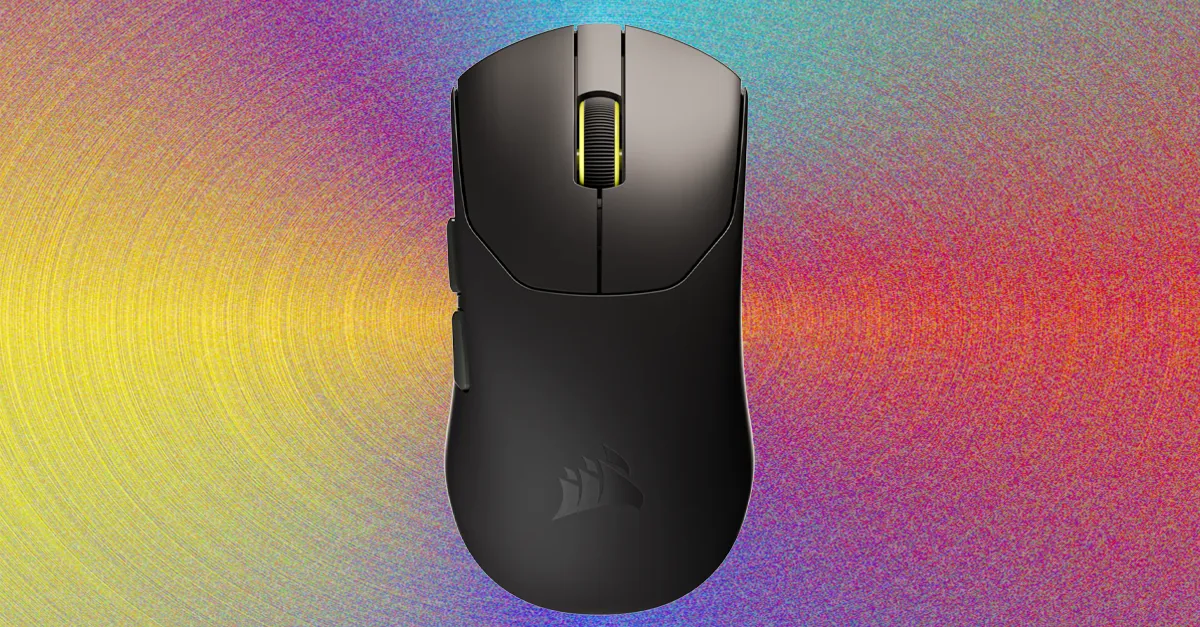
For the past few years, competitive gaming mice have been on a weight loss journey. For a serious ultra-lightweight wireless gaming mouse today, the “acceptable” weight is around 60 grams—in part because the mouse still feels rigid and substantial in-hand. You can still slip your mouse into a backpack or drop it from a reasonable height without worrying about anything cracking or breaking.
But what if someone made a mouse as light as possible, without worrying about structural rigidity or durability? How much weight could be shaved off? Corsair’s new Sabre V2 Pro Ultralight clocks in at only 36 grams; compared to big names like Razer, Logitech, and SteelSeries, this mouse is only two-thirds the weight of their lightest models. Next to smaller, competition-focused companies like Hitscan, the Sabre v2 Pro is neck-and-neck. It raises the question: Can a mouse be too light for its own good?
The Sabre v2 Pro Ultralight costs $100 and is available in black and white. The mouse includes a 2.4-GHz dongle for wireless connectivity, a USB-A to USB-C cable, grip tape, and an additional set of larger mouse skates.
Unmatched Performance
Colin Chapman, founder of the esteemed car company Lotus Cars, had a well-known ethos about designing race cars: “Simplify, and add lightness.” This philosophy was the driving force behind the car brand for decades, bringing it countless podiums across multiple racing leagues, along with producing some of the greatest sports cars ever to come out of Britain.
However, there’s a reason Lotus isn’t a household name: The vast majority of its cars traded quite a few things for lightness—comfort, reliability, and general build quality—in exchange for top-of-the-line performance. Worthwhile for some, but not compelling enough to overthrow big names like Porsche and Ferrari.
In a similar way, Corsair’s new gaming mouse is unbelievably light. Thirty-six grams is the lowest weight of any gaming mouse from a mainstream manufacturer. It feels practically weightless and can be flung around with ease. The sensor is precise and snappy, capable of up to 33,000 dots per inch (dpi), and the mouse has a polling rate of up to 8,000 Hz, meaning it will send messages to your computer up to 8,000 times a second—a number that matches top-tier models from Razer and Logitech.
The Sabre v2 Pro’s shell has a smooth, matte finish that makes it easy to grip and move around. There are noticeable moulding lines on either side of the mouse, but these avoid any touchpoints on the mouse. The switches have fairly short travel distances and have distinct “click” sounds when pressed. Scrolling is relatively smooth, with a subtle ratcheting that is noticeable but not disruptive. The mouse wheel has a rubberized finish on top to improve grip. It wobbles very slightly from side to side, bu not enough to be irritating.
Instead of optical switches, the Sabre opts for mechanical switches. This means lower power consumption, which allows for more battery life from a smaller battery. Optical switches will have slightly faster response times and will last much longer due to their contactless design. There is a trade-off for the additional weight savings, but it feels worthwhile.
The only way I can describe the feeling of holding and using this mouse is that it sits somewhere between single-use plastic and carbon fiber. You hold it in your hand, and your brain tells you that it’s cheap because of how light it is. The plastic is flimsy; it could easily crack or break, and you could probably crush it by sitting on it. Yet, somehow, it works. Once you’re in a rhythm with it, any concerns fade away—your hand glides along, unaware of the mouse’s weight, and you enter a zen-like state of aim that’s uninhibited by banal concepts like build quality and structural rigidity.
Looking at the Sabre v2 Pro’s underside, you’ll notice that the indentations for the mouse feet are far larger than the feet themselves. There is also a set of larger feet in the package, and according to Corsair, the smaller ones were used for greater weight savings and reduced friction. Switching over to the larger feet adds less than a gram of weight (I measured an increase of 0.4 grams) and makes the mouse feel more consistent and easier to control. The benefits of the larger feet significantly outweigh the downsides for regular use, although I could see some folks preferring the smaller feet for the added agility.
Limited Usability
Instead of Bluetooth connectivity, this mouse has a 2.4-GHz receiver for wireless connectivity. This dongle is a small plastic rectangle with a female USB-C port on the back—connect this to your PC to power and pair the receiver with the mouse. There’s also a plastic clip on the underside of the receiver. Corsair says the clip attaches the dongle to your mousepad to create “minimal signal interference and a steady connection.” In my tests, the connection was serviceable even at 20-plus feet.
The lack of Bluetooth connectivity is, presumably, for weight savings, but it makes this mouse inconvenient as a travel option. The lack of rigidity already makes traveling with it seem unwise. It’s meant to be kept on a desk.
The mouse has a total of five buttons: The left and right clicks, the middle click, and the two side buttons, which are mapped to “forward” and “back” by default. There are five built-in sensitivity presets, ranging from 400 to 2,000 dpi. These presets can be adjusted, and the number of presets can be decreased. With the default button maps, you can cycle through the presets by holding down the right click and back button for three seconds. The scroll wheel will flash three times to indicate that the setting has changed. It’s a little convoluted. More importantly, the dpi switch only works if the rear side button is mapped to the “back” key. When I remapped this button to anything else, the combination didn’t work.
Corsair recently unveiled its in-browser Web Hub utility, replacing its iCue software for peripheral management. It’s a vast improvement, being easier to navigate and less issue-prone than its predecessor. With the utility, you can easily adjust settings like polling rate, dpi, and button mapping. However, a mouse this simple really doesn’t have much to adjust. I quickly remapped the side buttons, cranked the polling rate to 8,000 Hz, and never needed to use the software again (outside of testing). The only catch is that in-browser management means you need an internet connection, though maybe you have bigger issues if that’s the case.
The Sabre v2 Pro also includes rubberized “grip tape” stickers, applied to the primary buttons and either side of the mouse. These can improve grip and only increase weight by half a gram, but they don’t make a massive difference in functionality unless you have particularly sweaty hands. More than anything else, it makes the mouse feel softer and provides some added comfort. However, I found that the tape was limited-use. After removing and reapplying it a couple of times, the edges started to peek back when holding the mouse.
By Any Means Necessary
This mouse has an ethos of lightness at any cost. It weighs practically nothing, to the point that it feels surreal when you’re holding it. You can easily flex the plastic by squeezing either side of the mouse, and pressing from the top and bottom too hard will cause one of the side buttons to actuate. Pressing hard on the mouse from any side causes a small creaking noise to emit from the shell.
Cracking open this mouse is tough. It’s only held together by two screws in the back, with the rest of the fasteners being small plastic clips that need to be pulled apart. Because of this, repairability isn’t great—these small clips typically have a high risk of breaking during disassembly.
Once the mouse is open, the ridiculous thinness of the case becomes obvious—the outside edge of the top housing measures between 0.65 and 0.75 mm, and the raised outer edge of the bottom housing is just under 3.2 mm, with the center being even thinner. The top housing can easily be flexed and manipulated by hand, and could likely be ripped in half with moderate effort.
While all of this might not sound great for rigidity, it really is impressive just how little material Corsair was able to use to make this mouse. Getting a mass-produced, mass-market mouse below 40 grams is no small feat, and this mouse demonstrates just how much work it takes. The weight savings of this mouse are so extensive that the inside of the scroll wheel even has cutouts inside the barrel to shave off an extra fraction of a gram of plastic.
This is a great mouse if you want lightness above all else. I really like it. However, if you prioritize anything else—rigidity, durability, refinement, a generally “premium” feeling—this is not the mouse for you. You have to accept that nearly every other aspect of its design is heavily compromised in exchange for a lightness that really should not be possible.



